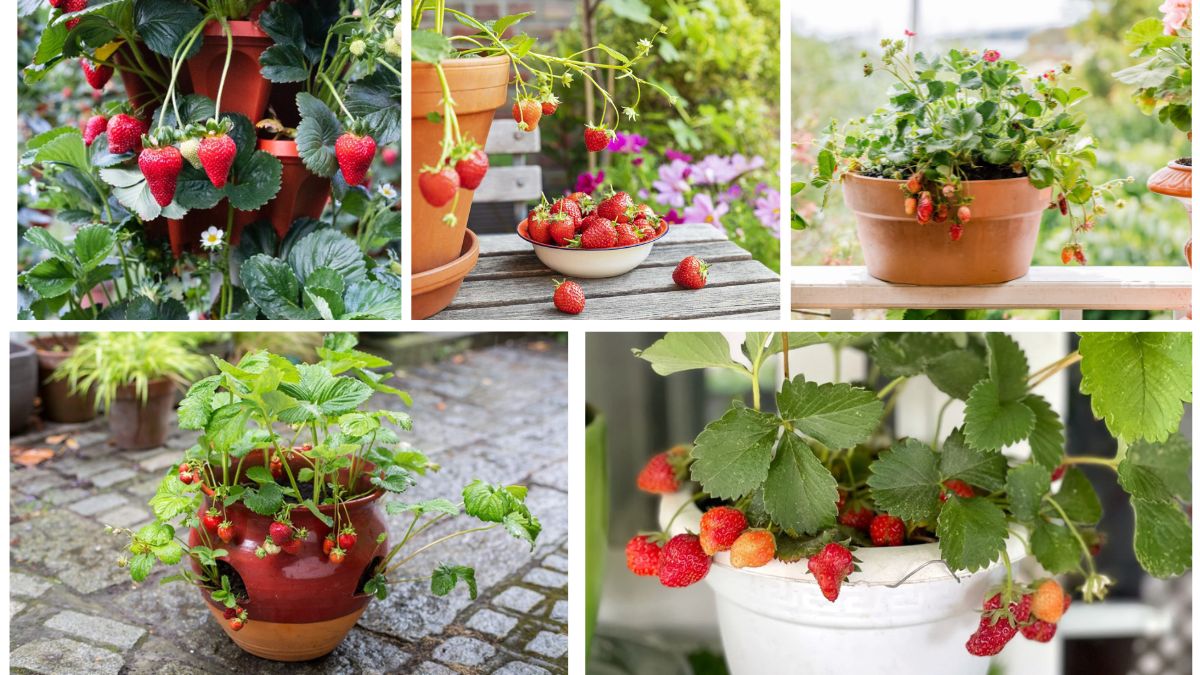Strawberries are one of the most beloved fruits in the world—sweet, juicy, and bursting with flavor. But did you know you don’t need a large garden to enjoy a bountiful harvest? Growing strawberries in pots is a simple and rewarding way to enjoy fresh berries right at home, even if you only have a balcony, patio, or small space. With the right setup and care, you can grow strawberries successfully in containers and enjoy their delicious taste all summer long.
This step-by-step guide will walk you through everything you need to know about growing strawberries in pots easily—from choosing the right variety to harvesting your juicy red fruits.
Why Grow Strawberries in Pots?
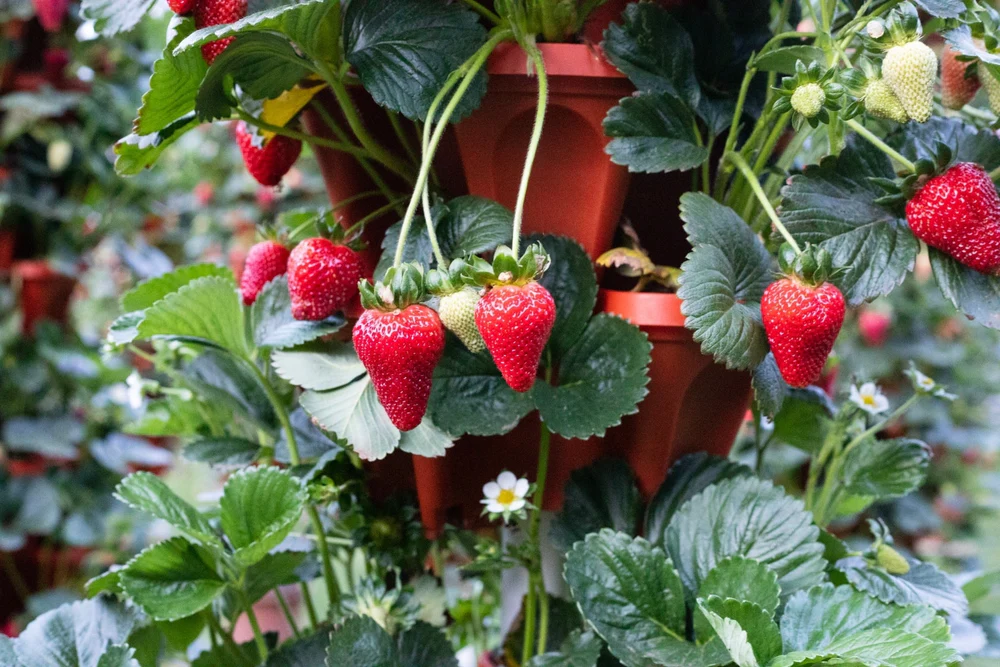
Before diving into the steps, let’s explore the benefits of growing strawberries in containers:
- Space-Saving Solution – Ideal for balconies, patios, or small yards.
- Mobility – You can move pots around to follow the sun or protect plants from harsh weather.
- Pest Control – Growing in pots helps reduce slug and snail damage compared to ground planting.
- Better Soil Control – You can provide the perfect well-draining soil mix for healthy growth.
- Decorative Touch – Strawberry plants are not only productive but also add greenery and beauty to your space.
Choosing the Right Strawberry Variety for Pots
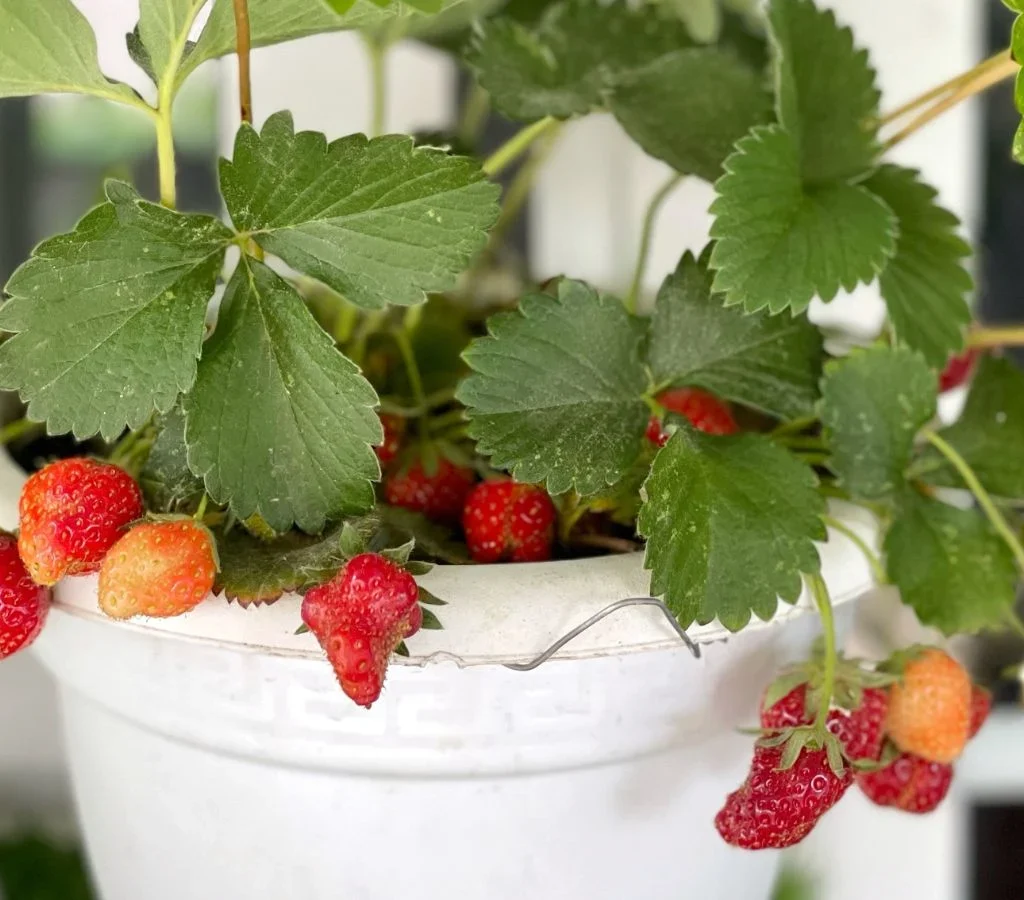
Not all strawberries grow equally well in containers. Some varieties are better suited for pots because of their compact size and prolific fruiting habits. Here are the three main types of strawberries:
- June-Bearing Strawberries
- Produce a large crop once a year, usually in late spring or early summer.
- Great for bulk harvesting but not continuous fruiting.
- Everbearing Strawberries
- Produce two to three harvests during the growing season.
- A good choice if you want a steady supply of berries.
- Day-Neutral Strawberries
- Produce fruits continuously throughout the growing season (as long as conditions are favorable).
- Ideal for pots and beginners since they provide regular harvests.
Recommended Varieties for Containers:
- Albion (day-neutral, high yield, large sweet berries)
- Seascape (day-neutral, disease-resistant)
- Mara des Bois (everbearing, aromatic and flavorful)
- Tribute (day-neutral, compact size perfect for pots)
Best Pots for Growing Strawberries
The type of container you choose has a big impact on the health of your strawberry plants.
- Size: Pots should be at least 12–16 inches deep and wide to allow room for root growth.
- Material: Terracotta, plastic, or ceramic pots work well. Hanging baskets and strawberry towers are also excellent options.
- Drainage: Ensure the container has sufficient drainage holes to prevent root rot.
Pro Tip: For multiple plants, choose larger pots or tiered containers designed specifically for strawberries.
Preparing the Perfect Soil Mix
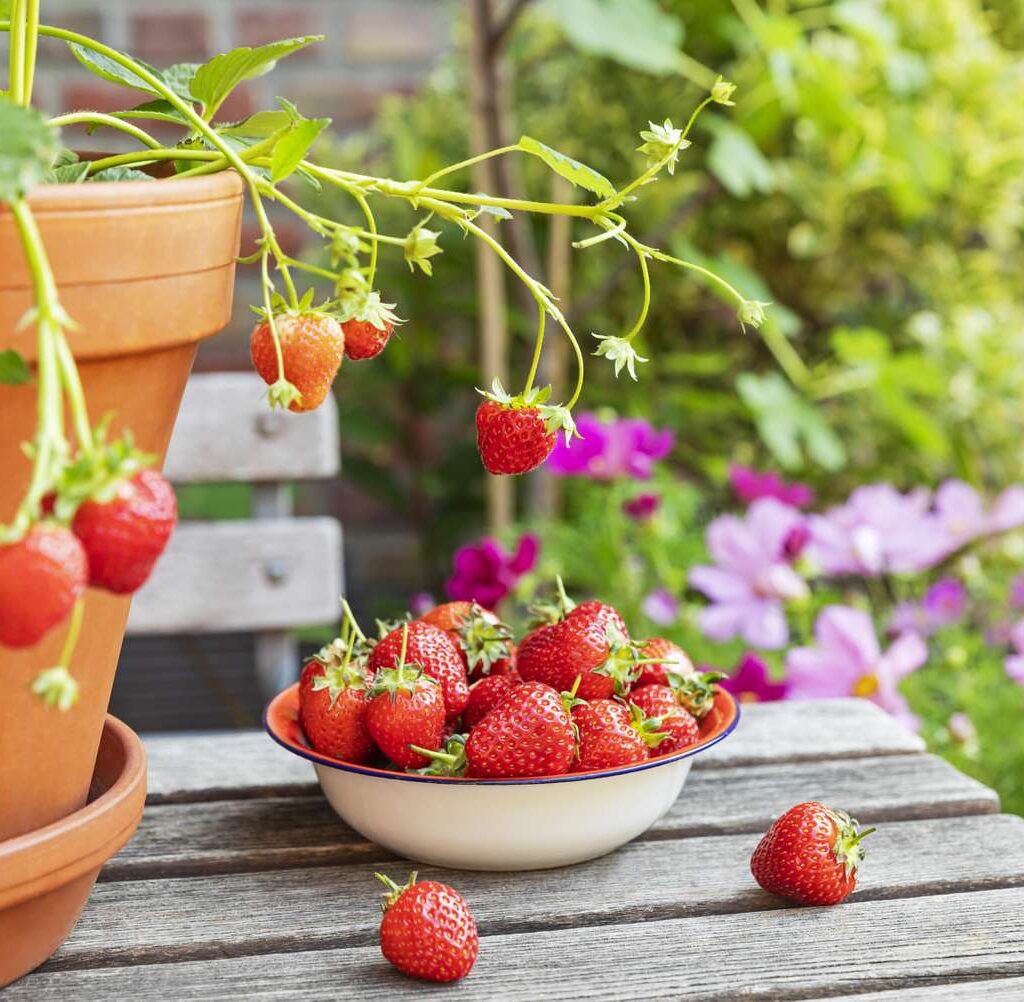
Strawberries thrive in well-draining, nutrient-rich soil. Since pots dry out faster than garden beds, the right mix is crucial.
Soil Mix Recipe for Strawberries in Pots:
- 1 part high-quality potting soil
- 1 part compost or organic matter
- 1 part perlite or coarse sand for drainage
Soil pH: Keep the soil slightly acidic, between 5.5 and 6.5.
Planting Strawberries in Pots Step by Step
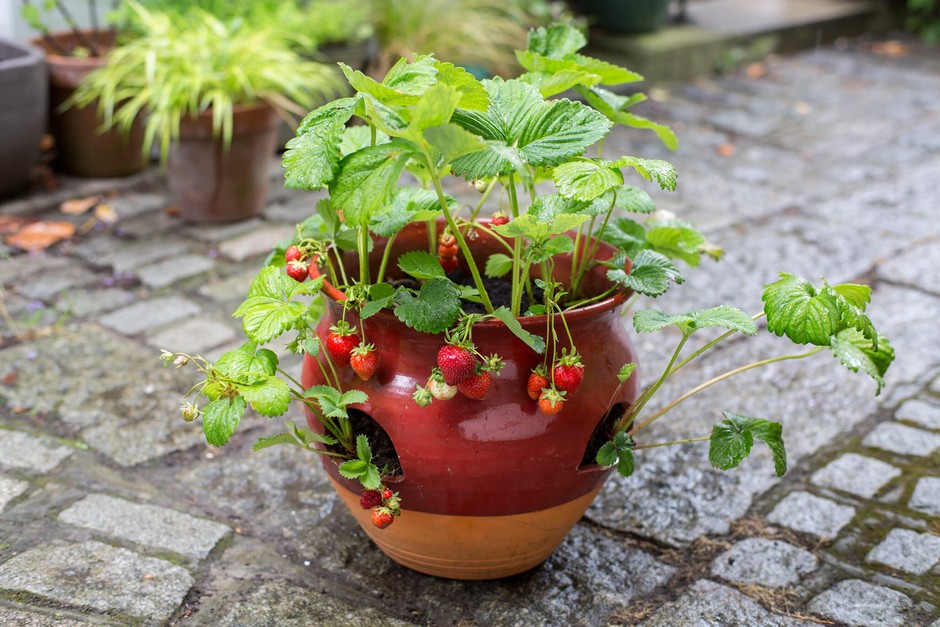
- Fill the Container – Add soil mix up to 2–3 inches below the rim.
- Prepare the Plants – If planting bare-root strawberries, soak roots in water for 20 minutes before planting.
- Planting Depth – Place the crown (where leaves meet the roots) at soil level. Planting too deep can cause rot, while planting too shallow can dry out roots.
- Spacing – In larger pots, space plants 8–10 inches apart. In smaller containers, limit to 1–2 plants.
- Water Well – After planting, water thoroughly to settle the soil.
Watering and Sunlight Needs
- Sunlight: Strawberries need at least 6–8 hours of direct sunlight daily. Place pots in a sunny location.
- Watering: Keep soil consistently moist but not waterlogged. Potted strawberries dry out faster, so check daily during hot weather.
- Mulching: Add straw, pine needles, or coco coir on top of the soil to retain moisture and keep fruits clean.
Feeding and Fertilizing
Strawberries are heavy feeders and benefit from regular fertilization.
- At Planting: Mix in a slow-release organic fertilizer.
- During Growth: Feed every 3–4 weeks with a balanced liquid fertilizer (10-10-10).
- While Fruiting: Switch to a fertilizer higher in potassium to boost fruit production.
Caring for Strawberry Plants in Pots
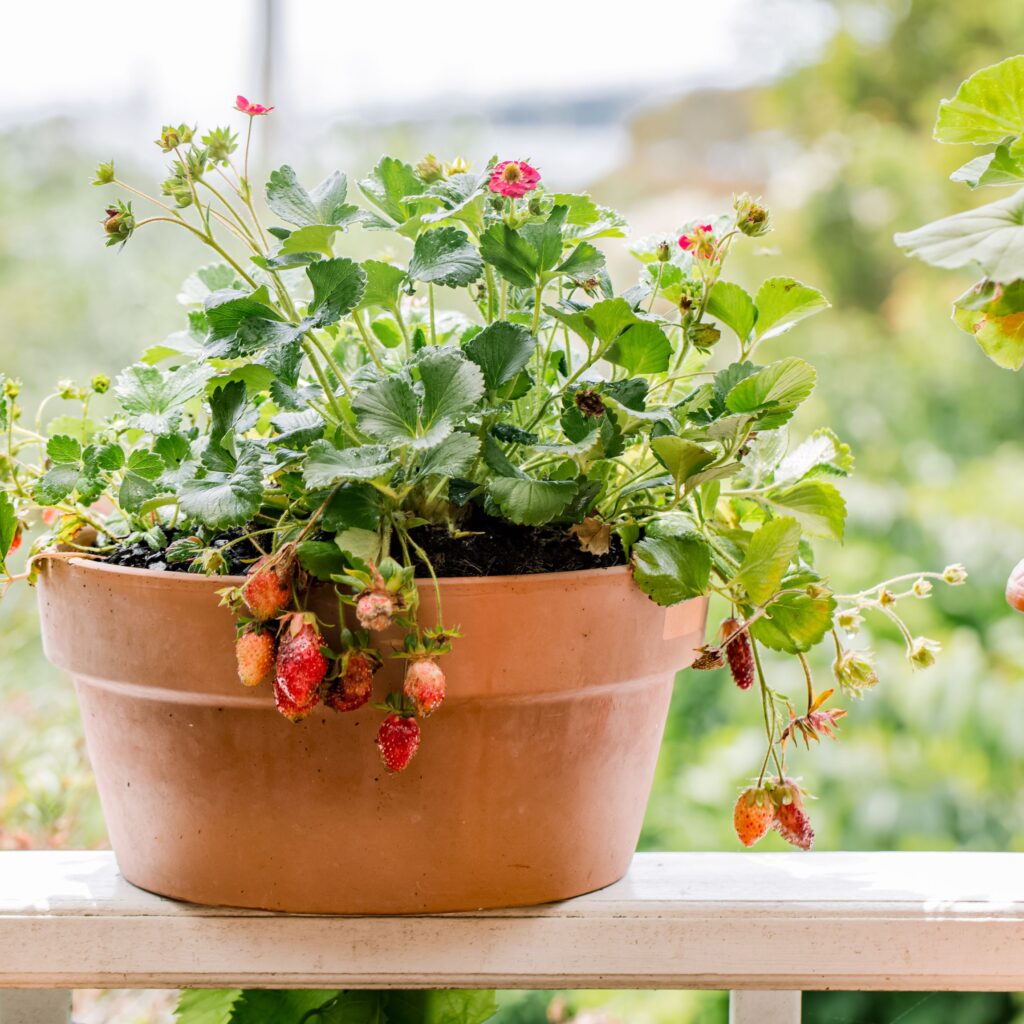
- Pruning Runners – Strawberries send out runners (long stems that form new plants). For potted plants, trim runners to encourage the main plant to produce more fruit.
- Winter Protection – In colder climates, move pots indoors, into a greenhouse, or wrap them with insulating material.
- Pest Control – Watch for aphids, spider mites, and slugs. Neem oil or insecticidal soap works well for pests.
- Disease Prevention – Avoid overhead watering to reduce fungal diseases. Always water at the base.
Harvesting Strawberries
- Strawberries are ready to harvest when they are fully red, plump, and glossy.
- Harvest every 2–3 days during the peak season.
- Gently twist the berry off the stem instead of pulling to avoid damaging the plant.
- Freshly picked strawberries taste sweetest when eaten the same day but can be refrigerated for 2–3 days.
Common Mistakes to Avoid
- Overcrowding the Pot – Leads to poor airflow and disease.
- Planting the Crown Too Deep – Causes rot and plant death.
- Inconsistent Watering – Dry soil stresses plants; waterlogged soil leads to root rot.
- Neglecting Fertilizer – Potted plants need regular feeding to produce abundant fruits.
Creative Ways to Grow Strawberries in Pots
- Hanging Baskets – Beautiful and space-saving, with fruits dangling down attractively.
- Strawberry Towers – Vertical planters with multiple planting holes allow you to grow many plants in a small footprint.
- Mason Jars or Buckets – Upcycled containers make charming strawberry planters.
- Balcony Rail Planters – Great for small urban spaces, letting strawberries grow along the railing.
Final Tips for Success
- Start with healthy nursery plants or bare-root strawberries.
- Keep pots in the sunniest location possible.
- Regularly check soil moisture and adjust watering according to weather.
- Remove old leaves and runners to keep plants vigorous.
- Replace strawberry plants every 2–3 years since they decline in productivity.
Conclusion
Growing strawberries in pots is one of the easiest and most rewarding ways to enjoy fresh fruit at home. With the right variety, soil, and care, you can harvest juicy, flavorful berries from even the smallest spaces. Whether you use hanging baskets, decorative pots, or a strawberry tower, this method makes it possible for anyone to grow their own strawberries.
So why wait? Grab a pot, plant your strawberries, and look forward to sweet, homegrown harvests right outside your door!
